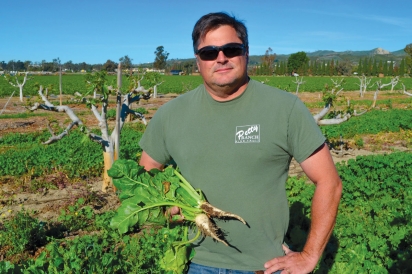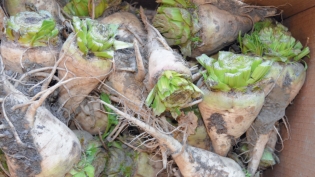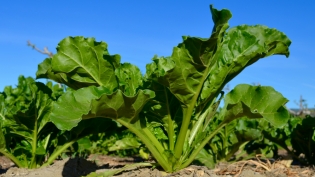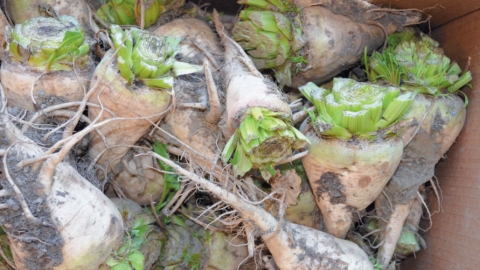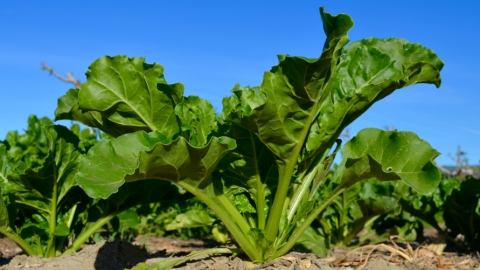Sugar Beets
New roles for Ventura County’s original cash crop
The sugar beet once loomed large in Ventura County agriculture. From the end of the 19th century to 1959, sugar grown and produced locally played a significant role in our economy. The American Beet Sugar Factory was the first major employer in Oxnard, named for the sugar-mogul siblings who founded both the factory and the town. (Between 1899 and 1959, the factory produced nearly 4 billion pounds of granulated sugar.)
A major factor in the sugar beet’s decline was the improvement of local irrigation systems that enabled more lucrative citrus, berry and vegetable crops to displace the sugar beets grown only with the winter’s rains. Sugar beets largely disappeared from the local scene.
Until recently.
Since 2005, we have relied on winter rains to grow cover crops in our citrus and fi g orchard in Saticoy. This year we added the nearly forgotten sugar beet to the mix. (Cover crops let us capture water when it is plentiful and convert it to water-conserving soil biomass for our long, dry summers when water is especially precious, and to help sustain the soil that commercial successor crops need.)
The open-pollinated, non-GMO sugar beets joined barley, another former staple in Ventura County, as part of our cover crop strategy. While barley is an easy and inexpensive way to protect soil from erosion, sugar beets play a different role: Their deep roots are ideal for breaking up the clay soil in our orchard. They produce a tremendous amount of carbonrich biomass, several hundred pounds dry weight per acre, which helps to retain soil moisture once the beets have broken down.
Sugar beets are a notoriously nutrient-hungry crop, but that’s exactly why we want them. We hope they may help to capture and store excess nutrients that might otherwise escape to waterways or groundwater.
Some of our figs were actually too vigorous last season; a little competition might help manage growth and improve fruit quality. Soil salinity is an issue in Ventura County after several years of drought, and sugar beets are known to be more salt-tolerant than other covers and hardier, even without supplemental fertilizer.
While most of these benefits are characteristic of all beets, sugar beets add an educational dimension not possible with table beets. Planted among our fig trees, they were featured prominently this spring in the FarmLab program run by Students for Eco Education and Agriculture (SEEAG) to introduce school kids to agriculture.
The vegetable’s big roots make an excellent visual aid for demonstrating plant anatomy and the connection between plants and soil.
Kids are surprised to learn the beets are a source of sugar. It’s among the least identifiable farm products, humble yet ubiquitous, often hidden in a processed food’s ingredient list. A sugar beet is a great prop for discussions on food origins and healthy eating with the kids who visit our farm.
A Sweet Education
Recently, New York chef Dan Barber, who wrote The Third Plate: Field Notes on the Future of Food (The Penguin Press, 2014), has helped popularize the notion of “whole farm eating.”
Given this interest, we wanted to make more of the cover crops that we grow at Petty Ranch edible. This doesn’t mean they will all be harvested and consumed, as a cover crop’s job is to feed soil, not people. If we harvested everything for the dinner table, we’d lose much of the beneficial carbon, nitrogen and biomass that we worked so hard to produce.
Edible cover crops may be educational for consumers but, like any new crop, they are an education for the farmer as well. Some crops are easy to grow, but hard to grow well. So it is with sugar beets.
It will take us a few years to work out the best practices for planting, weeding and controlling the gophers that have gone after the sugar beets with gusto. Post-harvest handling to ensure the best quality from a sugar beet will be very different than what we’re used to with citrus, avocados or figs.
And as always, each year brings its own challenges. The “Godzilla” El Niño rains promised a great year for dry-farming sugar beets, but were later and lighter than expected, impacting our schedule and our yield.
The Next Trendy Veggie?
Sugar beets are more tapered in shape than typical beets and have lots of fine roots. There are clefts where dirt tends to stick. They have a shock of robust leafy greens sprouting from the root’s crown. They’re not the prettiest, or the tastiest, member of the Beta vulgaris clan.
Roasted with a bit of salt and pepper, they are a mild and slightly sweet root vegetable. Pleasant, but not particularly memorable. They lack the minerally flavor people either love or hate in the colorful purple beets we usually see.
On the other hand, embracing their trademark high sugar content offers opportunities for people with a passion for food to experiment. We are very excited to be making a few of our beets available to some local food and beverage professionals.
The biggest transformation could come at the hands of Michael Machuzak and Joe Freas of Channel Islands Distillery in Ventura, who juiced about 250 pounds of sugar beets to make a small-batch rum.
“Depending on taste coming out of the still [as a silver rum], we plan to age it in a glass vessel with oak chips. We are planning on a very unique oak for this,” says Freas.
Experimentation doesn’t have to stop at the farm gate!
Is the sugar beet destined to be a major crop once again in Ventura? I don’t imagine that it will. But it will have a place on my farm, and perhaps a place in the kitchens, markets and distilleries of our county as well.



